Green Campus Tour – East Side
The University of Illinois Chicago is updating a brutalist concrete jungle to a sustainable urban oasis every day. Go out and experience our green transformations on campus. Follow the spatial directions by using the interactive UIC map.
Test your knowledge! Play the UIC Climate Commitments Scavenger Hunt
Lecture Center Plaza (The Quad) Heading link
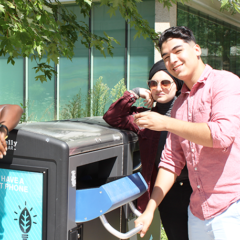
The tour begins in the Lecture Center Plaza, also known as the Quad. Here, we can see multiple Big Belly solar compactor recycling bins. These bins were placed in outdoor areas to accommodate the large number of bottles and cans that are disposed in this Lecture Center Plaza. These “Big Bellies” help reduce our carbon footprint because they have sensors that tell us when they are full- so we only have to send the garbage or the recycling truck when necessary. They also compact the refuse to make pick-ups very infrequent. The first eight refuse and recycling containers were funded by the UIC Sustainability Fee. And because they were able to prove to UIC how successful they are, the university purchased additional bins for the campus!
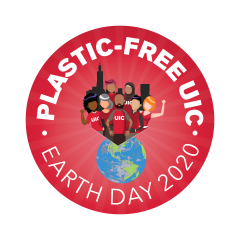
Did you know that UIC recycles more than 50% of its trash? In fact, 3,500 tons of paper, plastic, metal, and glass were recycled just last year alone! Inside UIC’s buildings, paper is separated from the rest of the recycling materials to ensure that uncontaminated paper gets recycled into usable products. This extra step helps to save over 40,000 trees each year! UIC accepts plastic, too, but this material is more difficult to recycle so it is best to avoid plastic as much as possible. UIC celebrated the 50th anniversary of Earth Day in 2020 with a big campaign to end single-use plastics on campus.
Student Center East Heading link

To the east of the Lecture Center Plaza is Student Center East, one of the places on campus where food scraps are composted. Each year, UIC collects and composts roughly 120 tons of food scraps! Composting is better for the environment because instead of rotting away in the landfill, producing methane – a powerful greenhouse gas and contributor to climate change – the organic food materials decompose quickly into useable fertilizer. At times, UIC is even able to use the compost in our gardens!

UIC Dining Services partners with the Food Recovery Network (FRN) to help the local community and the environment by putting less food into the landfills. Since July 2014, they have shared over 15 tons of leftovers from the kitchens in SCE as well as UI Health to homeless shelters and other community organizations!
Chicago Circle Memorial Grove Heading link
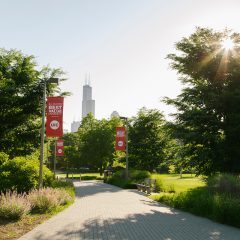
Next, head south to the corner of Taylor and Morgan streets and you can experience how Walter Netsch originally designed this garden with its elliptical asphalt path, low granite benches, and surrounding brick wall in 1968 to match the architecture style of the rest of the campus in the late 1960’s. The new design was the outcome of a collaborative process involving the Campus Master Plan implementation committee, students, and the landscape architects. The Chicago Circle Memorial Grove (or “Grove” for short) is now a friendly and distinguished entry point, inviting people to relax and interact, but still retains many of the landscape features – trees and shrubs, and the circular layout. It is commonly used as an outdoor recreation space boasting many sustainable features.
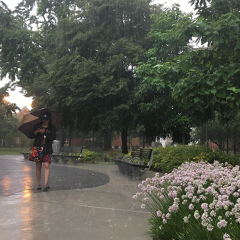
There are about 2500 Sustainable Landscaping plants – perennials, groundcovers and grasses- that are native or hardy in our climate were planted to minimize future maintenance and watering and reduce stormwater runoff, while providing beauty. Many plants at UIC are maintained in accordance with the Campus Pollinator Habitat Plan, which outlines way to reduce pesticide use. This has helped UIC to be initially designated as an affiliate of Bee Campus USA in 2017, becoming the first certified campus in Illinois. Since then, UIC has established annual activities to engage its community in enhancing pollinator habitats on campus.
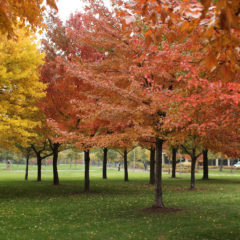
The Grove showcases only a small sample of the nearly 5,000 trees all over campus! UIC is among the few universities that participate in the tree campus higher education program, which since 2011, has promoted effective tree management, campus community involvement, and nature connectivity among faculty members and students through forestry efforts. Together, UIC’s trees help sequester 70,000 pounds of carbon dioxide annually, remove nearly 3,000 pounds of air pollutants, and avoids nearly 100,000 cubic feet of stormwater each and every year, thus helping to reduce climate change impacts. Want to know the specific tree you are looking at and what benefits it can provide you? Look it up using the UIC Tree Inventory!
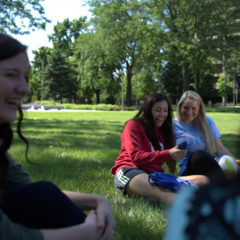
Other sustainable features of the Grove include the lighting (which was retrofitted to LEDs which will save 12,100 kW/yr in electricity), the 2900 sq. feet of permeable paving (which allows rain water to permeate directly into the ground and keeping it out of our already challenged storm sewers), a bike parking hub (installed under the Science and Engineering Office building, allowing for sheltered parking of 70 bikes), and 10 old Granite benches (that were salvaged and made into new benches). And what happened to the fence that blocked UIC from the rest surrounding community? 770 linear feet of the old iron fencing was removed and was refurbished for use at Granderson Stadium.
Prairies at the Engineering Innovation Building Heading link
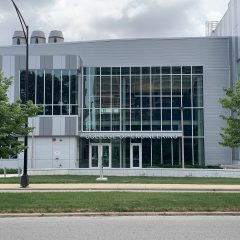
Just across Taylor Street you will discover one of the newest buildings on campus. The Engineering Innovation Building (EIB) was designed to be sustainable with a goal to achieve LEED®certification. The building’s exterior façade assembly is designed to help lower the urban heat island effect common in urban areas, allow for great daylighting and views into every office, lab, administration areas, and student lounge. Inside, you will find areas to safely store bicycles (along with a shower room to accommodate bike commuters!)
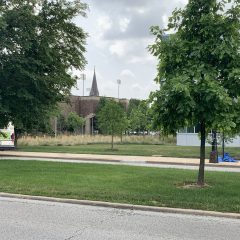
The building was constructed on the north half of Parking Lot 5, so no green space was lost. Its native landscape design and shading trees not only help our Net Zero Water and Biodiverse Campus goals, but also provide enjoyable views, walks, and places to sit. The grasses in the south courtyard and just to the east of the building are unlike traditional turf you may be accustomed to. These are native grasses that grow taller and should not be mowed down. These grasses will bloom and attract local pollinators like bees and butterflies that enhance the diversity of insects that visit our campus. UIC was the first college or university in Illinois to receive the Bee Campus USA designation! UIC promises to be mindful of the importance of pollinators in our landscaping.
Daley Library Heading link
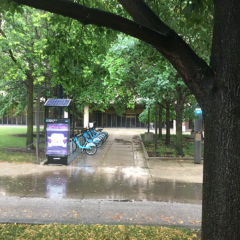
Go north on Morgan Street and you will find the Daley Library. Just outside the library’s west entrance is one of many Divvy bicycle stations on campus. Faculty, staff, and students are offered a discounted rate for the yearly membership and can use these Divvys all around town. With multiple stations dispersed through the campus, you’ll be sure to get where you’re going quickly!
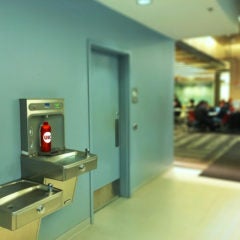
The Daley Library has filtered water bottle refilling stations, eliminating the need for 1-time use plastic bottles of water. You can also find other water bottle fill stations in many other buildings on campus by selecting “Water Refill Station” under the Top Destinations category in the UIC map (The first water refill stations were also funded by the Sustainability Fee!)
Parking Lot 1A Heading link
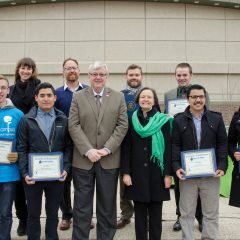
North near the intersection of Vernon Park Place and Morgan Street is a parking lot just west of the Behavioral Sciences Building. Parking lot 1A has porous concrete below the parking stalls, which can reduce stormwater runoff to help prevent flooding and improve water quality of receiving water bodies like Lake Michigan and the Chicago River.
Environmental monitoring equipment has been installed for measuring rainfall, soil moisture characteristics under the permeable concrete, and the outflow from underdrains to the city sewer. These measurements of the water balance for the site will allow for assessing the long-term performance of green infrastructure and help guide future implementations. This is all thanks to a group of UIC students that developed a stormwater master plan titled “Urban Transformations: A Phased Approach to Green Infrastructure Implementation,” and won the U.S. Environmental Protection Agency’s Campus RainWorks Challenge!
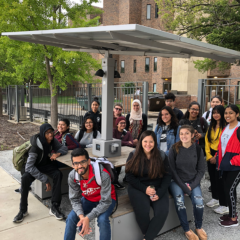
The parking lot also utilizes LED lighting, and solar-powered picnic tables so you can charge your computer or cell phone while enjoying the green space just west of the Behavioral Science Building. This project was made possible by the Sustainability Fee brought forth by a BRIGHT idea of a group of UIC students!
Green Roofs Heading link
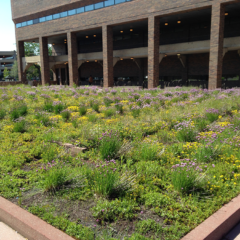
Across Harrison Street you will experience a partial green roof on the Education, Theater, Music & Social Work building plaza area. A green roof is a structural surface covered with plants and vegetation and are more attractive than traditional roofs; they reduce the Urban Heat Island Effect (a phenomenon where cities become warmer due to dark surfaces of city infrastructure, increasing air conditioning and energy needs that produce pollution and greenhouse gases); they insulate a building and lower heating/cooling demands; and they reduce the amount of stormwater runoff by absorbing rainfall before it enters Chicago’s sewers.
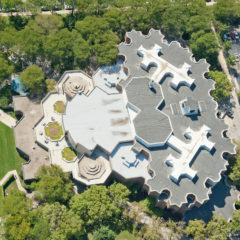
Other building that feature a green roof is the Behavioral Sciences Building (which is publicly accessible) and on the Art & Architecture Building, Academic and Residential Complex, and James J. Stukel Towers (not publicly accessible). An alternative to Green Roofs, some UIC buildings have White Roofs, usually a soy-based white painted surface with extra insulation, that save energy by reflecting the light usually absorbed on traditional rooftops. These buildings include BSB, Student Center West, Student Residence Commons, Jefferson Hall, Science & Engineering South, and the Physical Plant Building.
Academic Residential Complex (ARC) Heading link
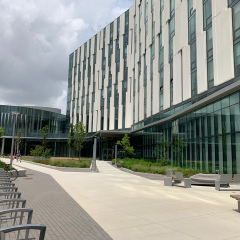
The Academic and Residential Complex (ARC) building is both a residence hall and classroom facilities. ARC’s large windows allow for natural daylight, contributing to UIC’s Carbon Neutral Campus goal. The classroom side of the building has recycling stations with multiple, flexible collection bins to allow for future waste streams like composting, helping us to achieve our Zero Waste Goal. The native plant rain garden landscaping techniques reduces stormwater and attracts pollinators, helping both our Net Zero Water and Biodiverse Campus goals. ARC was certified LEED Gold in March 2020!
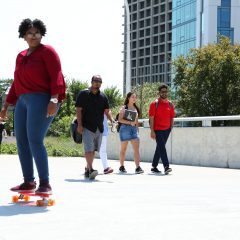
Visiting a friend in the residence hall or taking a class in one of ARC’s state-of-the-art classrooms? Well, it is certainly a breeze to get to! It is mere steps from the CTA Halsted Blue Line stop and has both a Divvy station and bike racks out front for those biking using Chicago’s robust on-street bike network. UIC is proud of our that we have been designated a Bike Friendly University offering dedicated bike lanes, shower facilities, fix it stations and part of the robust Chicago-based Divvy bike sharing network.
Some cool facts about Biking at UIC:
- Bring your Helmet to any UIC Recreation Center, and they will give you 30 minutes to clean up in the locker room.
- If you find yourself with low tire pressure, stop by one of the Fix-It stations to borrow a bike pump or repair kit.
- There are over 1,000 outdoor bike parking spaces at UIC at nearly every single building on campus.
Geothermal Well Field Heading link
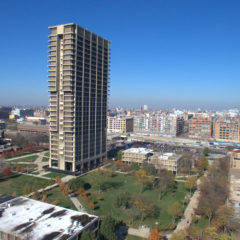
A large green space just east of University Hall houses an underground vertical labyrinth of pipes. This is the geothermal system that consists of 64 wells that heat and cool the air using geothermal renewable energy in Grant, Lincoln, and Douglass Halls. As tall as University Hall is, that’s how deep the structure sits underground – nearly 350 feet!
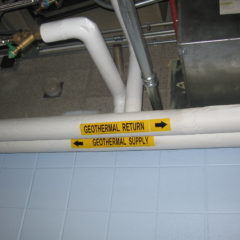
This building uses a closed-loop system with sensors, heat pumps and air exchangers, taking advantage of the relatively constant earth temperatures in the well field to maintain a comfortable indoor air environment year-round. In the winter, the closed loop pipes bring up the ‘heat of the earth’. An electric compressor collects the warmth, and the building’s Heating, Ventilation, and Air Conditioning (HVAC) system distributes the warm air. In the summer, the process goes in reverse. The pipes draw away the indoor heat and carry it back underground.
LEED GOLD Complex Heading link
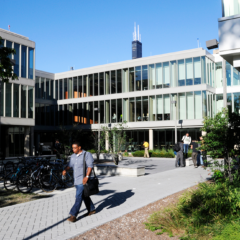
Three beautifully renovated classroom buildings are Grant, Lincoln, and Douglass Halls (Gold) – the latter two of which earned LEED Gold certification. LEED (Leadership in Energy & Environmental Design) is the US Green Building Council’s rating system for design, construction and maintenance of high performance, energy efficient, and green interiors, buildings, and communities. In 2010 Lincoln Hall became UIC’s first LEED certified building, earning Gold certification and one year later Douglass Hall earned LEED Gold certification as well! Since then, UIC has pledged to follow LEED standards in small projects where possible and to pursue a minimum LEED Gold certification for all large capital projects.
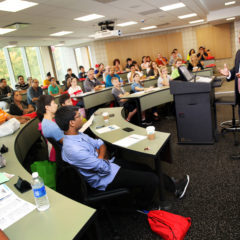
LEED buildings include the full range of sustainability features found in many buildings around campus: efficient building systems that include LED or fluorescent lighting, large windows to maximize natural light; energy from renewable resources (like solar panels); water-efficient systems and landscaping, use of recycled or sustainably harvested materials for flooring and workspaces; and low-VOC (volatile organic compound) paints and glues, improving indoor environmental quality.
Douglass Hall’s floors are made from recycled rubber tires on the 2nd and 3rd floors. Both Lincoln and Douglas Halls have automated shades to manage heat load. The building has a cooling sensor on the roof to detect the heat load inside the buildings. Then, the system automatically adjusts lights, cooling/heating levels, and heights of window blinds in order to regulate the building temperature.
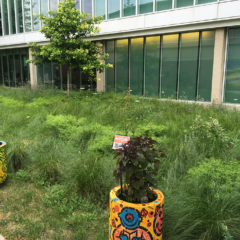
The south end of Lincoln Hall is especially beautiful during warmer months, when many birds and butterflies spend time in the Bioswale, drawn by the blooming of native prairie plants. Permeable pavers make up the pathways weaving between Douglas Hall, Grant Hall, and Lincoln Hall, allowing water to pass underground and eventually replenish Lake Michigan. Grant Hall, Lincoln Hall and Douglas Hall also conserve water through low-flow fixtures and dual-flush toilets in the restrooms.
A few years after the LEED certification of Lincoln Hall, a team of students from the Sustainability Internship Program (SIP) and an Industrial Engineering Design Team researched restroom water usage in Taft Hall (which is what Lincoln Hall used to look and operate like before the renovations.) The team found that water usage by the toilets could be reduced 72% from this replacing the automatic and/or high-flow fixtures to manual and low-flow fixtures, with a payback shorter than a year, and greatly reduce maintenance costs.
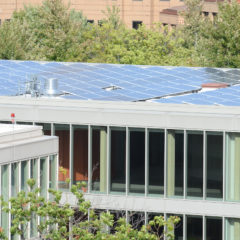
Lincoln and Douglas Halls use on-site renewable energy that helps reduce our campus’ carbon footprint. The rooftops of Douglas Hall and Lincoln Hall boast a total of 469 solar panels that generate electrical power by converting solar radiation into direct current (DC) electricity to provide a portion of the buildings’ electricity needs. The amount produced annually by both buildings is enough to provide electricity for almost seven average 2-bedroom apartments!
With the photovoltaics system (solar panels), there is no need to burn coal, oil, or natural gas elsewhere to produce electricity. We use a free power source, sunlight (a long-lasting source) to eliminate all direct greenhouse gas emissions related to the generation of electricity. It’s completely clean energy!
Want to see the energy they are producing right now?
Heritage Garden Heading link
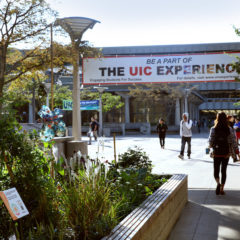
Funded by the Sustainability Fee since its beginning in 2013, the Heritage Garden is a project of the Centers for Cultural Understanding and Social Change. The gardens serve as an interactive learning space to teach students about environmental and cultural sustainability. Each plant, flower, vegetable and herb has significance and relates to culture and heritage. Currently, there are eight satellite gardens on the east side of UIC’s campus.
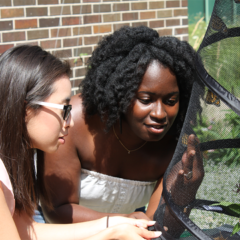
Planted on the east side of Lecture Center B is the Monarch Butterfly Habitat which houses more than 14 different native and pollinator-friendly plants, including variants of milkweed and biannual, biennial, and perennial nectar plants. These plants are located in an area with more than six hours of sun a day. The milkweed plants serve as shelter and a food source for monarch larvae until they hatch into butterflies, while nectar plants serve as a food source for pollinators, including butterflies and bees. These gardens not only bring the UIC campus to life every spring, but they also give the UIC community the opportunity to appreciate nature and art.
What about the west side? Heading link
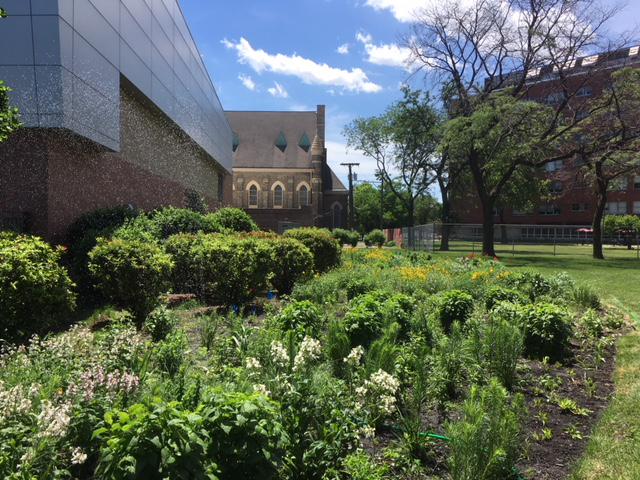
The west side of campus also has sustainable spaces and places – many of which are featured in the Scavenger Hunt!
- Mile Square Health Center was awarded LEED Gold and is the most energy efficient health care building on campus.
- Little Prairie on the Campus transformed a 2,000 square foot grassy area into a pollinator-friendly habitat.
- Arthington Mall Plaza project renovated a high-traffic, outdoor space to install green infrastructure like permeable pavement and rain gardens to reduce thousands of gallons of stormwater runoff each year.
- The UI Health Green Team has been working on many initiatives throughout the past year to promote sustainability and environmental stewardship by increasing the hospital recycling rate, decreasing food waste, and engaging and educating staff.
- The UIC Nutrition Teaching Garden lets students grow their own food for instructional classes.
Did You Know... Heading link
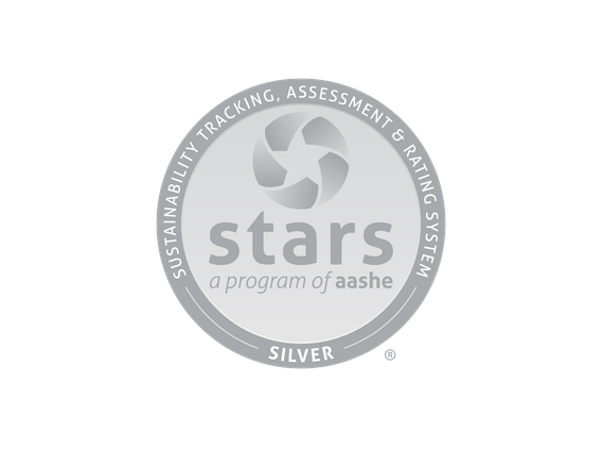
UIC is rated at the Silver Level of the Sustainability Tracking, Assessment & Rating System™(STARS). STARS is a transparent, self-reporting framework for colleges and universities to measure their sustainability performance. The Association for the Advancement of Sustainability in Higher Education has recognized that we have done very well in various categories that span the breadth of higher education sustainability: Academics, Engagement, Operations, and Planning & Administration.